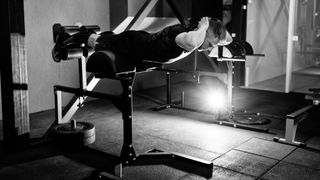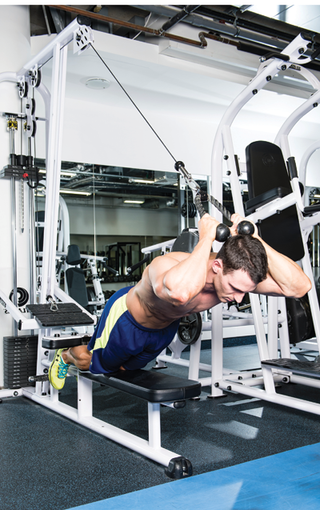
If sports performance, injury prevention or just having bigger legs matters to you – and if none of those apply then a guide to a lower-body exercise is a surprising choice of reading material – then neglecting the muscles at the backs of your thighs is a big mistake.
“Many runners, footballers and cyclists are quad-dominant, which means they use the front thigh muscles far more often than the hamstrings,” says Nick Mitchell, founder of Ultimate Performance. “Muscular imbalance between the front and back of the thighs places excessive strain on the hip and knee joints, so injuries are common. Training the hamstrings will address any imbalance, improve sprinting and turning speed, and also add serious muscle mass to your legs to help you squat and deadlift more.”
One of the best ways to train your hamstrings is by performing a raise on a glute-ham developer. The exercise recruits more muscle fibres than a hamstring curl on a machine and targets all three heads of the hamstrings, as well as your glutes.
“This move really hits your hamstrings and glutes as well as working the calves and lower back to strengthen your posterior chain,” says Mitchell. “It also improves knee and hip extension, which can help you avoid injury, and places less stress on the lumbar spine than other hamstring-focused moves, such as Romanian deadlifts.”
Try the exercise by using the form guide below, and if it turns out to be too tough, then carry on down to the variations section where you’ll find an easier version of the glute-ham raise.
How To Do The Glute-Ham Raise

For the full version of the exercise head to the gym, unless you have a garage that’s supremely well stocked with fitness equipment, because you need to use a glute-ham developer (GHD). Adjust it so that when your feet are secured your quads are resting on the middle of the GHD and you can lower your torso over the end. Start with your knees bent at 90° so your body is straight and perpendicular to your lower legs. Your arms should be folded across your chest. Brace your core and slowly lower your torso forwards over the edge of the GHD until you are horizontal. Then return to the starting position explosively by contracting your hamstrings.
If you don’t have a GHD to work with, you can perform the exercise by kneeling on a mat and getting a gym buddy to hold your feet in place as you lean forwards.
Get the Coach Newsletter
Sign up for workout ideas, training advice, reviews of the latest gear and more.
Glute-Ham Raise Variations
Pull-down glute-ham raise

Using the lat pull-down machine offers the same benefits as the main move, but holding a double-rope cable attached to the weight stack counterbalances your bodyweight, making it a perfect beginner move for gradually building hamstring strength. Start by setting the weight stack to the right level of resistance. Kneel facing away from the machine with the backs of your calves against the pad. Hold the double-cable rope attached in both hands just behind your head, with your elbows pointing up. Slowly lower your upper body towards the ground, keeping your core braced. Then quickly return to the starting position by contracting your hamstrings.

Sam Rider is an experienced freelance journalist, specialising in health, fitness and wellness. For over a decade he's reported on Olympic Games, CrossFit Games and World Cups, and quizzed luminaries of elite sport, nutrition and strength and conditioning. Sam is also a REPS level 3 qualified personal trainer, online coach and founder of Your Daily Fix. Sam is also Coach’s designated reviewer of massage guns and fitness mirrors.
